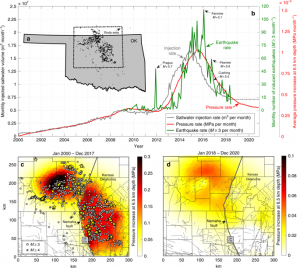
Despite low level earthquakes reported in recent weeks, a new study claims the number of man-made earthquakes in Oklahoma and Kansas has been reduced following steps by regulators in the two states to control wastewater injection wells.
The report also suggests there will be a continuing drop in potentially damaging quakes in the next few years. USA Today reported this week on the study that was first published in the peer-reviewed British journal Nature Communications.
According to the study, “if current injection practices continue, earthquake hazards are expected to decrease slowly.”

At the same time, scientists at Stanford University say they looked at earthquakes in Oklahoma and Kansas as they created a technique to predict man-made quakes before they happen.
Oklahoma’s induced earthquakes increased drastically in 2009 and peaked in 2015, according to Stanford University. In order to reduce the quakes, Oklahoma regulators mandated a 40 percent water injection reduction in early 2016. The number of earthquakes soon declined.
The researchers’ predicted decrease in quakes over the next couple of years follows this recent trend.
“The result of the new study is definitely good news – it shows injection rate reductions are still effective,” study lead author Cornelius Langenbruch said in a statement. “In 2015 and 2016 the probabilities were as high as 70 percent. However, the problem is that earthquake probabilities in some areas are still much higher than historic rates.”
The new model shows there will be a 32 percent, 24 percent and 19 percent probability of potentially damaging earthquakes of magnitude 5.0 or above in 2018, 2019 and 2020, respectively, showing that Oklahoma’s policies are working.






